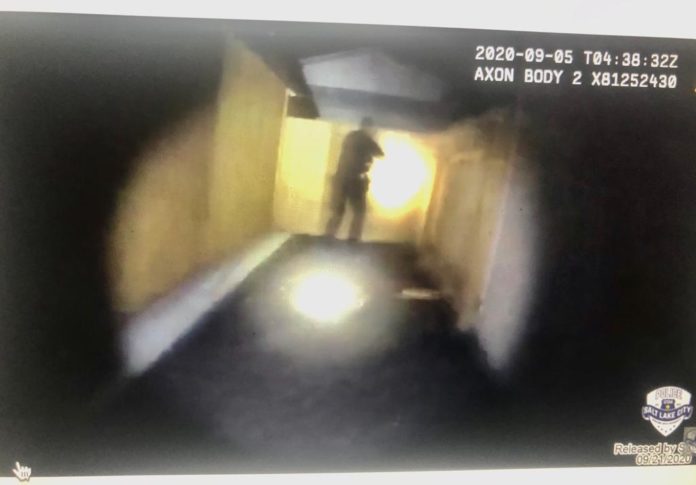
SALT LAKE CITY, Utah, Nov. 25, 2020 (Gephardt Daily) — The parents of a 13-year-old boy who was shot multiple times by a Salt Lake City police officer have filed a lawsuit against the police department.
The boy, Linden Cameron, has autism and was having what police later described as a “mental episode” when they responded to a call for a crisis intervention team shortly after 10 p.m. on Sept. 4 of this year.
The lawsuit, which was filed in U.S. District Court in Utah on Monday, names Chief Mike Brown, Salt Lake City Corporation, the officer who shot the teen, and the other officers who were on scene as defendants in the case.
The plaintiffs in the lawsuit are Linden’s mother, Golda Barton, and his father, Michael Cameron.
In a statement released Monday, the family’s attorneys wrote that an officer shot the teen at least 11 times.
“We can inform you that Linden is continuing to recover and that he is learning to cope with his changed life,” the attorneys wrote. “We are grateful that the bullets were not fatal, however, many of his injuries appear to be permanent and will forever change the trajectory of his life, both physically and emotionally. This tragic shooting should not have happened.”
The lawsuit alleges that the teen was shot even though he was unarmed and had not committed any crime.
It further states that when Golda Barton called 911, she informed the dispatcher that she needed a mental health worker because her son was sick. She also told the officers when they arrived at her home, in the area of 500 South and Navajo Street, that Linden has a “sensory disorder,” was afraid of police and would probably run away from them, the lawsuit alleges.
Despite these cautions from the mother, the lawsuit claims that the subject of shooting was raised by the officer who later shot Linden. He allegedly stated, “Especially when he hates cops, it’s going to end in a shooting.”
According to the lawsuit, this statement was made while the officers were discussing whether they should even approach the teen or instead call a sergeant for guidance. They didn’t call a sergeant or seek guidance and, instead, “descended on (Linden’s) home with their guns drawn,” the lawsuit states.
As officers knocked on the door, Linden ran out from the back of the house and down an alley, where he confronted an officer “whose body camera clearly showed (Linden’s) bare, empty hands, clearly indicating that (Linden) was unarmed,” the lawsuit states.
It further alleges that the officer who shot Linden kicked through a wooden fence with his gun already drawn and began chasing the boy as he passed by the fence; and although the officer was armed with a Taser, he never removed it from its holster nor did he attempt to use any less-lethal weapons.
“Chasing down a young child and shooting him 11 times from behind is certainly the most glaring of the wrongdoings,” the attorneys wrote in the public statement. “However, multiple other failures in protocol and procedure increased the probability of unnecessary violence.”
They then refer to several failures on the part of the officers at the time of the incident, such as failure to attempt to de-escalate the situation and to use less-than-lethal force, failure to seek guidance from their superiors, and failure to intervene when it was clear that Linden was in danger and when he was handcuffed after being shot multiple times and was left lying on his back on his injured arm.
Last month, the Salt Lake City Police Department announced that, beginning in November, it would become the first department in the nation to be “certified sensory inclusive.” In a news release, the department said all of Salt Lake City’s first responders: SLCPD, Salt Lake City Fire Department and 911 dispatch will take part in the training through KultureCity.
“KultureCity’s training will focus on instilling understanding, acceptance, and empathy in the city’s first responders toward those who have sensory needs,” the news release said.
SLCPD also hopes to highlight its Autism Safe Registry, a voluntary program where people register to provide 911 and officers responding to a call with important information about the needs of the people they may encounter at their address, according to the news release.
In the statement released Monday by the attorneys for Linden’s family, they wrote that they are aware that Salt Lake City has announced it will partner with KultureCity in an attempt to improve SLCPD’s training relating to persons with invisible disabilities.
“Whether these decisions and efforts will help to improve SLCPD’s future actions is yet to be seen,” they wrote. “However, those decisions will not deter the civil lawsuit we have filed nor will they reverse the violent harm that SLCPD and its officers caused to Linden. We expect SLCPD to take seriously the need for real reform and change.”
Later in September, Salt Lake City Police Department released body cam videos of the officer-involved shooting incident, as well as audio recordings of the 911 calls and radio transmissions.
The video below, from the body camera of the officer who shot Linden, is 18 minutes and 26 seconds long. It shows the officer’s initial contact with Linden’s mother as she explains what has been going on and that she needs the officers to take her son to the hospital. It then shows the officers approach the house and pursue Linden as he runs from them, until the officer fires the shots and Linden falls to the ground. Linden can be heard saying after the shooting, “Tell my mom I love her.”
This second video, which is 18 minutes and 22 seconds long, shows the incident from another male officer’s point of view.
A third video, which is 18 minutes and 31 seconds, shows the incident from the body-worn camera of a female officer.
The final video, which is one minute and 40 seconds long, shows officers chasing the juvenile from the point of view of a fourth officer, who says repeatedly: “Get on the ground,” then “Pull your hands out.”
Two 911 calls from Linden’s mother and the audio recording of the radio traffic are below.





